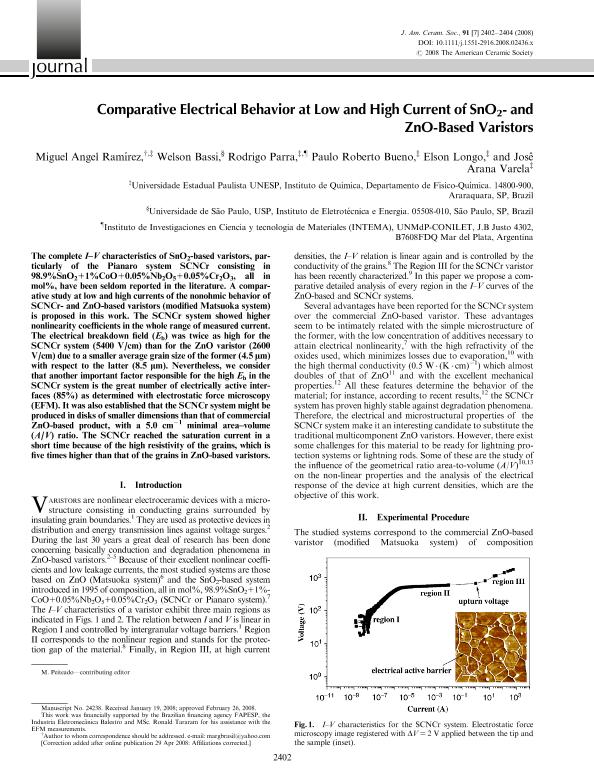Mostrar el registro sencillo del ítem
dc.contributor.author
Ramírez, Miguel Ángel
dc.contributor.author
Bassi, Welson
dc.contributor.author
Parra, Rodrigo

dc.contributor.author
Bueno, Paulo Roberto
dc.contributor.author
Longo, Elson
dc.contributor.author
Varela, José Arana
dc.date.available
2019-01-14T18:08:01Z
dc.date.issued
2008-07-08
dc.identifier.citation
Ramírez, Miguel Ángel; Bassi, Welson; Parra, Rodrigo; Bueno, Paulo Roberto; Longo, Elson; et al.; Comparative electrical behavior at low and high current of SnO 2- and ZnO-based varistors; Wiley Blackwell Publishing, Inc; Journal of the American Ceramic Society; 91; 7; 8-7-2008; 2402-2404
dc.identifier.issn
0002-7820
dc.identifier.uri
http://hdl.handle.net/11336/67982
dc.description.abstract
The complete I-V characteristics of SnO 2-based varistors, particularly of the Pianaro system SCNCr consisting in 98.9%SnO 2+1%CoO+0.05%Nb 2O 5+0.05%Cr 2O 3, all in mol%, have been seldom reported in the literature. A comparative study at low and high currents of the nonohmic behavior of SCNCr- and ZnO-based varistors (modified Matsuoka system) is proposed in this work. The SCNCr system showed higher nonlinearity coefficients in the whole range of measured current. The electrical breakdown field (E b) was twice as high for the SCNCr system (5400 V/cm) than for the ZnO varistor (2600 V/cm) due to a smaller average grain size of the former (4.5 μm) with respect to the latter (8.5 μm). Nevertheless, we consider that another important factor responsible for the high E b in the SCNCr system is the great number of electrically active interfaces (85%) as determined with electrostatic force microscopy (EFM). It was also established that the SCNCr system might be produced in disks of smaller dimensions than that of commercial ZnO-based product, with a 5.0 cm -1 minimal area-volume (A/V) ratio. The SCNCr reached the saturation current in a short time because of the high resistivity of the grains, which is five times higher than that of the grains in ZnO-based varistors.
dc.format
application/pdf
dc.language.iso
eng
dc.publisher
Wiley Blackwell Publishing, Inc

dc.rights
info:eu-repo/semantics/openAccess
dc.rights.uri
https://creativecommons.org/licenses/by-nc-sa/2.5/ar/
dc.subject
Sno2
dc.subject
Zno
dc.subject.classification
Físico-Química, Ciencia de los Polímeros, Electroquímica

dc.subject.classification
Ciencias Químicas

dc.subject.classification
CIENCIAS NATURALES Y EXACTAS

dc.title
Comparative electrical behavior at low and high current of SnO 2- and ZnO-based varistors
dc.type
info:eu-repo/semantics/article
dc.type
info:ar-repo/semantics/artículo
dc.type
info:eu-repo/semantics/publishedVersion
dc.date.updated
2019-01-14T15:04:38Z
dc.journal.volume
91
dc.journal.number
7
dc.journal.pagination
2402-2404
dc.journal.pais
Reino Unido

dc.journal.ciudad
Londres
dc.description.fil
Fil: Ramírez, Miguel Ángel. Universidade Estadual Paulista Julio de Mesquita Filho; Brasil
dc.description.fil
Fil: Bassi, Welson. Universidade de Sao Paulo; Brasil
dc.description.fil
Fil: Parra, Rodrigo. Consejo Nacional de Investigaciones Científicas y Técnicas. Centro Científico Tecnológico Conicet - Mar del Plata. Instituto de Investigaciones en Ciencia y Tecnología de Materiales. Universidad Nacional de Mar del Plata. Facultad de Ingeniería. Instituto de Investigaciones en Ciencia y Tecnología de Materiales; Argentina
dc.description.fil
Fil: Bueno, Paulo Roberto. Universidade Estadual Paulista Julio de Mesquita Filho; Brasil
dc.description.fil
Fil: Longo, Elson. Universidade Estadual Paulista Julio de Mesquita Filho; Brasil
dc.description.fil
Fil: Varela, José Arana. Universidade Estadual Paulista Julio de Mesquita Filho; Brasil
dc.journal.title
Journal of the American Ceramic Society

dc.relation.alternativeid
info:eu-repo/semantics/altIdentifier/url/https://ceramics.onlinelibrary.wiley.com/doi/abs/10.1111/j.1551-2916.2008.02436.x
dc.relation.alternativeid
info:eu-repo/semantics/altIdentifier/doi/http://dx.doi.org/10.1111/j.1551-2916.2008.02436.x
Archivos asociados
